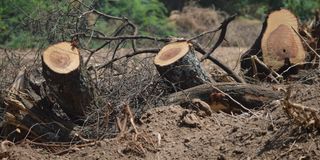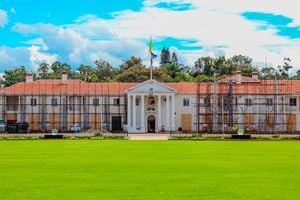Illegal loggers, charcoal makers in Baringo warned amid wanton felling of trees

Tree stumps left after trees were cut down to burn charcoal in Marigat sub-county, Baringo county on November 12, 2021.
What you need to know:
- Baringo South sub-county environment officer Kiprono Kimokiy issued a two-week notice to illegal charcoal producers and transporters in the region
- Governor Cheboi also attributed dwindling farm production to degradation of land that has led to soil erosion, flooding and frequent landslides
Illegal loggers and charcoal makers in Baringo County have been warned by the county’s top leaders, amid wanton felling of trees.
Governor Benjamin Cheboi and County Commissioner Abdirisack Jaldesa said the groups are worsening the effects of climate change.
They blamed perennial food insecurity, poor productivity and flooding in the region on climate change caused by human activities.
Governor Cheboi also attributed dwindling farm production to degradation of land that has led to soil erosion, flooding and frequent landslides.
“For us to be productive, we must ensure that our soils are favourable for agriculture and if we don’t embrace growing of trees, then soils will be washed downstream. We must protect our environment by planting trees to avoid erosion,” he said.
Climate change effects
Baringo has been hit hard by the effects of climate change, including perennial flooding.
In March 2020, water levels in lakes Baringo and Bogoria increased significantly, swallowing adjacent structures including hotels, business premises and social amenities.
The phenomenon also rendered more than 10,000 people bordering the lakes homeless after their houses were submerged.
Governor Cheboi, speaking at the swearing-in of his new deputy, Felix Maiyo, said destruction of water catchment areas is uncalled for and no one is allowed to encroach on riparian areas and start cutting down trees and making charcoal.
“Let us all take the responsibility of conserving the environment for our common good," her said.
Mr Jaldesa raised concerns that human activities have led to flooding in lakes Baringo and Bogoria and the drying up of the oxbow Lake Kamnarok in the Kerio Valley.
“We wonder why people are wantonly cutting down trees yet they have felt the effects of climate change. As we speak, the water in lakes Baringo and Bogoria are exponentially rising while Lake Kamnarok is almost drying up, all courtesy of human activities,” he said.
“We have, however, made an ultimate decision that the destruction of the environment must stop.”
Two week notice
Just recently, Baringo South sub-county environment officer Kiprono Kimokiy issued a two-week notice to illegal charcoal producers and transporters in the region.
In the notice copied to the county director for environment, Baringo South administrator, deputy county commissioner, sub-county forester and the Marigat police station commander (OCS), the environment officer warned that anyone found producing and transporting charcoal illegally will face legal action.
“Following the national moratorium on the ban [on] charcoal production in Kenya, notice is hereby given to all charcoal producers and transporters within Baringo South to stop forthwith the production and transportation of the same,” Mr Kimokiy wrote.
Lake Baringo has increased from 236km square in 2015 to about 278km square now, submerging adjacent structures including homes, institutions and social amenities.
The Kenyan government and the United Nations Development Programme (UNDP) studied the phenomenon and released the results in November last year.
The report cited three factors influencing the changes – climate change, siltation caused by human activities and geological and tectonic activities.
Rising water levels
Climate change was recorded as the main reason for the rising water levels, indicating that changes in land use practices have led to increased runoff, causing larger volumes of water to flow directly and rapidly from the land surface into the lakes.
As water levels in other lakes in the Rift Valley are rising exponentially, the oxbow Kamnarok on the floor of the Kerio Valley is receding at an alarming rate, thanks to human activities and degradation that have led to massive siltation, threatening its existence.
Environmentalists blame human activities like wanton cutting down of trees for charcoal and farming upstream.





